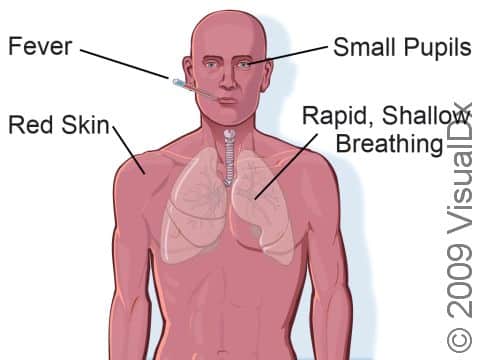Heatstroke, First Aid
Heatstroke, commonly known as sunstroke, is a form of heat illness. Heat illness occurs when a person’s core body temperature rises above a safe level of the body’s internal temperature range. Heat cramps are the earliest sign of heat illness. If efforts to cool off and rehydrate at this point are not made, the next stage of heat illness, heat exhaustion, can occur in a rapid progression, resulting in a potentially life-threatening situation. The most severe form of heat illness is heatstroke, which may result in shock, brain damage, or death.
See the Heat Cramps or Heat Exhaustion texts for information about the earlier stages of heat illness.
Who's At Risk?
People most susceptible to heatstroke are those outdoors on a hot, humid day or inside in a poorly ventilated area, particularly children, older adults, or people who are overweight. Children and older adults may experience the fastest progression of symptoms and can collapse suddenly.
Certain medications can make people more susceptible to heat illness because such medications can alter the way the body handles heat and sun.
People who drink alcohol before, during, or after vigorous activity are more susceptible to heat illness, as are people who do heavy work with inadequate fluid intake.
Even people in excellent health can experience heat illness if early symptoms are ignored.
Signs & Symptoms
A person with heatstroke may have:
- A high body temperature (above 102°F [38.9°C])
- Skin that is red and hot with lack of sweating (sweating has stopped)
- Small pupils
- A rapid, weak pulse
- Rapid, shallow breathing
- Extreme confusion or irritability
- Weakness
- Seizures
- Unconsciousness
You can differentiate the most severe form of heat illness, heatstroke, from less severe forms by comparing the person’s symptoms to those above. Less severe forms of heat illness can be identified as follows:
- Heat cramps include painful muscle cramps (eg, in the legs, arms, abdomen, or back), heavy perspiration, and general weakness / lightheadedness.
- Heat exhaustion includes feelings of nausea, lightheadedness, or thirst, and the person may act irrationally, have dilated pupils (pupils larger than normal), be very sweaty, or have cool and moist skin that is either red or paler than usual.
Self-Care Guidelines
First Aid Guide
When heatstroke is suspected, seek emergency medical care immediately.
While awaiting emergency medical services, try to cool the person using a combination of the following measures depending on the circumstances and means available:
- Have the person rest, legs slightly elevated, in a shaded area or in a cool or air-conditioned building, room, or car.
- Remove or loosen the person’s clothes.
- Give the person an electrolyte drink (eg, Gatorade or Pedialyte), clear juice, or water. Note: You can make a salted drink by adding 1 teaspoon of salt to 1 quart of water. Do not give beverages that contain caffeine or alcohol.
- Wrap the person in wet cloth, and position a fan toward them. Evaporation of water on the skin aids in cooling.
- Apply cold compresses (eg, to the neck, armpits, groin).
- Avoid strenuous activity.
Treatments
The medical professional will aim to cool the person down in a controlled fashion while ensuring they stay hydrated and have normal blood flow.
To reduce the person’s temperature as quickly and safely as possible, the medical professional may use different cooling techniques that involve immersion, evaporation, or invasive means. Medication may be given to control shivering, and urine output will be monitored. The person’s temperature will be monitored for days because they may have an unstable temperature for quite some time.
Visit Urgency
If you suspect heatstroke or there is associated shock, seizures, or unconsciousness, seek emergency medical care immediately.
Trusted Links
Last modified on August 9th, 2024 at 11:55 am

Not sure what to look for?
Try our new Rash and Skin Condition Finder
